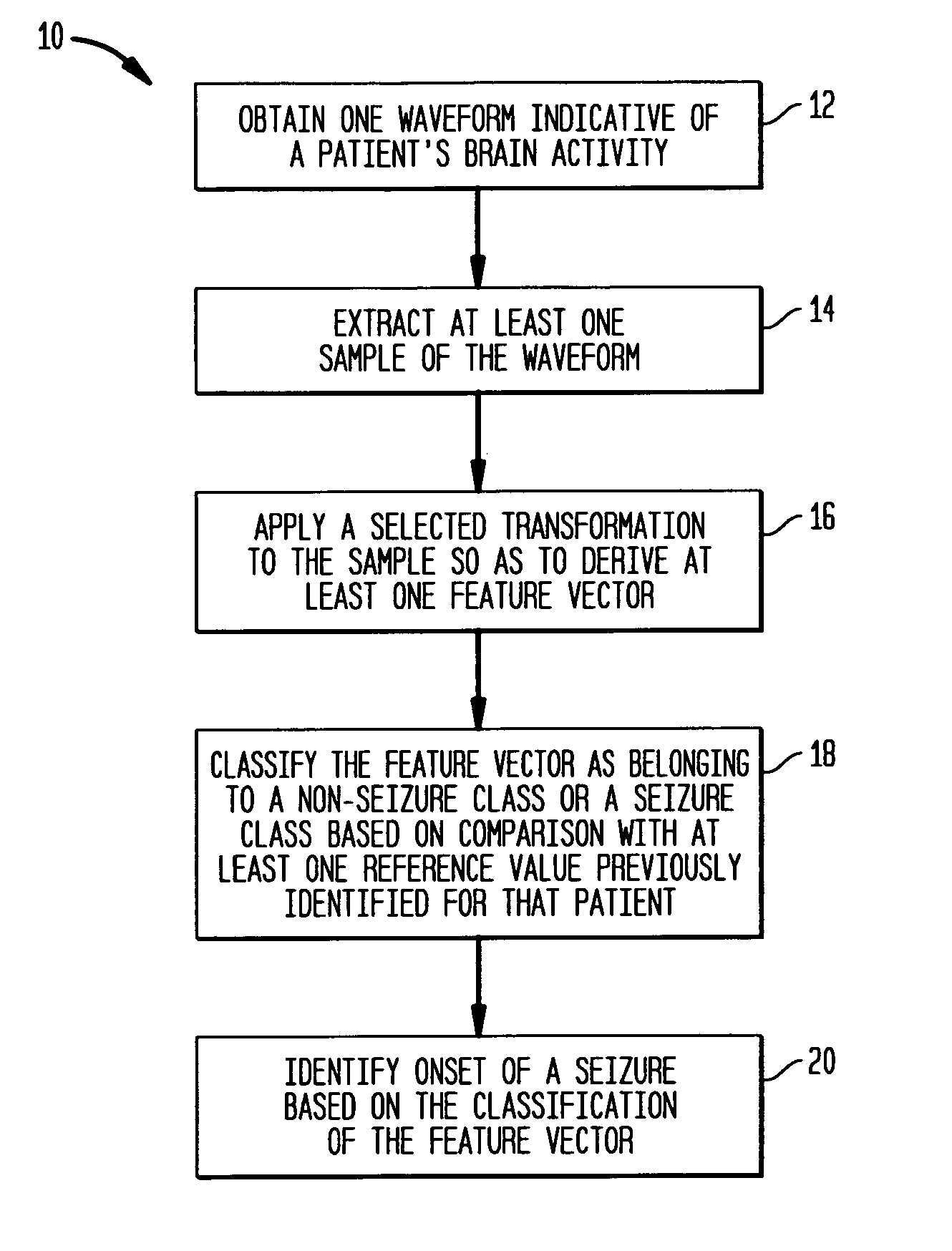Patient-specific seizure onset detection system
a detection system and patient technology, applied in the field of patient-specific seizure onset detection system, can solve the problems of severe injuries, burns and even deaths, and the optimal functioning of many such systems
- Summary
- Abstract
- Description
- Claims
- Application Information
AI Technical Summary
Benefits of technology
Problems solved by technology
Method used
Image
Examples
embodiment 21
where i corresponds to waveform channels (in this embodiment 21 channels are observed). wj=∑k∈Gjak j=1,… ,15Equation (10)
Training
[0268] In many embodiments of the invention, during training, the classifiers use a diverse set of examples from the seizure and non-seizure classes to determine decision boundaries. By way of example, in embodiments in which 21 derivations are employed, the training examples can be patient-specific, non-overlapping sets Si=1, . . . , 21, each containing selected epochs (e.g., two-second epochs) of labeled activity from a single EEG derivation. The epochs that correspond to seizure-related activity are labeled as examples of the seizure class, while those corresponding to both normal and artifact-contaminated activity from different states of consciousness are labeled as examples of the non-seizure class. It should be understood that training sets can be constructed in a similar manner in embodiments that utilize different number of derivations or...
case 1
[0271] As the first example, consider detecting the electrographic onset of the seizure illustrated in FIG. 33 by employing a detector according to the teaching of the invention having the SIP architecture. This seizure's onset is characterized by a paroxysmal, 10 Hz burst of sharp and monomorphic waves localized to the central derivations {Fz-Cz; Cz-Pz}, the right fronto-central derivations {FP2-F8; F4-C4}, and the right frontal derivations {FP2-F8; F8-T8, T8-P8}. With the exception of {FP1-F7; FP1-F3}, the derivations on the left side of the head, which are odd-numbered, show no appreciable change in behavior after the onset. These characteristics imply that the seizure originates from a region towards the front and right-side of the head.
[0272] The first step in the detection process is to train the detector not only on 2-4 previous occurrences of seizure onsets similar to that illustrated in FIG. 33, but also on the non-seizure EEG separating these occurrences. FIG. 34 shows on...
case 2
[0276] This case study highlights the importance of both localization and morphology to seizure detection, and the possibility of sharing certain types of non-seizure activity across the training sets of patients. Consider detecting the electrographic onset of the seizure illustrated in FIG. 38 again using a detector according to the teachings of the invention having the SIP architecture. This seizure's onset is characterized by a paroxysmal 2 Hz burst of monomorphic waves localized to the central derivations {FZ-CZ; CZ-PZ}, and all derivations on the right-side of the head {FP2-F4; F4-C4; C4-P4; P4-O2; FP2-F8; F8-T8; T8-P8; P8-O2}. The baseline EEG can be observed on derivations from the left-side of the head, which are odd-numbered, since they exhibit no change after the onset. This electrographic evidence indicates that the seizure originates from the right-side of the head.
[0277] To detect the test seizure shown electrgraphically in FIG. 38, the detector needs to be trained on ...
PUM
 Login to View More
Login to View More Abstract
Description
Claims
Application Information
 Login to View More
Login to View More - R&D
- Intellectual Property
- Life Sciences
- Materials
- Tech Scout
- Unparalleled Data Quality
- Higher Quality Content
- 60% Fewer Hallucinations
Browse by: Latest US Patents, China's latest patents, Technical Efficacy Thesaurus, Application Domain, Technology Topic, Popular Technical Reports.
© 2025 PatSnap. All rights reserved.Legal|Privacy policy|Modern Slavery Act Transparency Statement|Sitemap|About US| Contact US: help@patsnap.com



